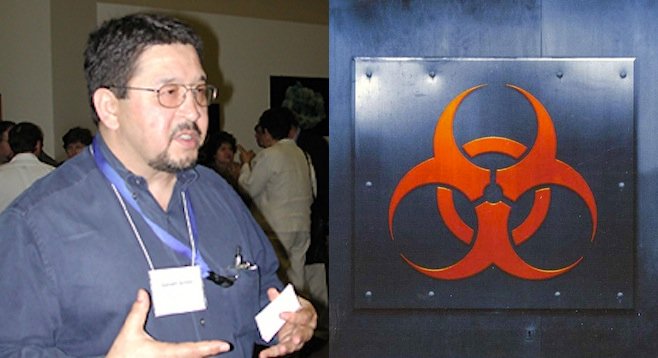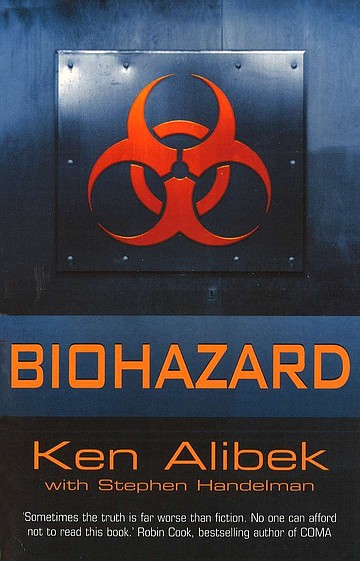 Facebook
Facebook
 X
X
 Instagram
Instagram
 TikTok
TikTok
 Youtube
Youtube

In the midst of the international panic spawned by the Ebola epidemic, it’s hard to tell what is going on at the top of America's biological warfare pyramid and whether it is having any effect on the course of the deadly contagion.

Some intelligence is supplied by Ken Alibek, author with Stephen Handelman of Biohazard: The Chilling True Story of the Largest Covert Biological Weapons Program in the World — Told from the Inside by the Man Who Ran It.
Little known by the general public, the 1999 book remains a must-read for bio warriors. It was the first citation in a July 2011 paper by Larry Zeitlin, president of Mapp Pharmaceuticals, the San Diego–based developer with the U.S. military of an anti-Ebola serum.
"It has been reported that [Ebola] was weaponized by the former Soviet Union," wrote Zeitlin and his co-authors. "Due to its infectiousness and the rapidity of modern travel, the potential exists for any outbreak to become an international epidemic."
In a March 2012 San Diego court filing, Mapp explained that its "primary business is to apply for and obtain grants from government agencies such as the Department of Defense and National Institutes of Health, to conduct research and develop biopharmaceuticals to combat infectious disease, prepare for outbreaks, and protect United States service men and women from biological warfare while serving our country abroad.”
Alibek's tome presents a look behind the scenes of Biopreparat, the Russian bio-warfare program that wasn't disassembled until well after the fall of the Soviet Union and, according to Alibek, has left behind a deadly legacy of germs, including Ebola and its Filovirus cousin Marburg, that could be set loose by terrorists and rogue states alike.
"Our scientists had found it more difficult to cultivate Ebola than Marburg — they were not able to reach the necessary concentration — but by the end of 1990, the long-term problem of cultivation had been solved and we were close to developing a new Ebola weapon," writes Alibek.
"The KGB was our most dependable supplier of raw material. They were known within Biopreparat by the code name 'Capturing Agency One.' Vials arrived in Russia almost every month with exotic fluids, powders, and cultures gathered by our intelligence agents in every corner of the globe."
In January 1991, the Soviets foiled a Western inspection tour of their bio war complex, says the book, by limiting their visitors to the first floor.
"In the upper levels were floors dedicated to work on smallpox, Ebola, Machupo, Marburg, Junin, and other hemorrhagic fevers, as well as VEE, Russian spring and summer encephalitis, and a number of other deadly viruses."
Arguing that the U.S. intelligence and military establishments have been remiss in tracking the subsequent fruits of the Soviet efforts, Alibek writes, "I have no way of knowing whether a combined Ebola-smallpox agent has been created, but it is clear that the technology to produce such a weapon now exists.
"To argue that these weapons won’t be developed simply because existing armaments will do a satisfactory job contradicts the history and the logic of weapons development, from the invention of machine guns to the hydrogen bomb."
After defecting to the West, Alibek began consulting with the U.S. military and worked in academia. In September 2004, he and associate Charles Bailey issued a report touting the technology of San Diego's Aethlon Medical, Inc., according to a company news release at the time.
"In their report, Alibek and Bailey discuss the potential of Aethlon's Hemopurifier cartridges to bind a wide variety of pathogenic enveloped viruses, including some hemorrhagic fever viruses that have already been weaponized and for which there is no effective treatment.
"According to the report, 'Aethlon clearly fills a large void in the armamentarium of available treatments for several organisms that may be released either as 'natural' epidemics or deliberately as weapons of bioterror.'"
In the wake of the present Ebola outbreak, Aethlon is again hyping the Hemopurifier, the latest surfacing of which occurred in a glowing U-T San Diego story on October 15.
"Ebola treatment is just one use of Hemopurifier, which by design provides a 'broad spectrum' antiviral capability,'" the paper said, adding that the device is being used on a Ugandan doctor with Ebola being treated in Germany.
According to the story, use of the Hemopurifier to treat Ebola is "the latest evidence of the [San Diego] region’s large and long-established biotech industry occupying the nucleus of international efforts to stop the viral epidemic."
But is the federal money spent here really making any difference?
Alibek's book leaves some doubt. "Some of the best scientists I’ve met in the West say it isn’t possible to alter viruses genetically to make reliable weapons, or to store enough of a given pathogen for strategic purposes, or to deliver it in a way that assures maximum killing power.
"My knowledge and experience tell me that they are wrong."


In the midst of the international panic spawned by the Ebola epidemic, it’s hard to tell what is going on at the top of America's biological warfare pyramid and whether it is having any effect on the course of the deadly contagion.

Some intelligence is supplied by Ken Alibek, author with Stephen Handelman of Biohazard: The Chilling True Story of the Largest Covert Biological Weapons Program in the World — Told from the Inside by the Man Who Ran It.
Little known by the general public, the 1999 book remains a must-read for bio warriors. It was the first citation in a July 2011 paper by Larry Zeitlin, president of Mapp Pharmaceuticals, the San Diego–based developer with the U.S. military of an anti-Ebola serum.
"It has been reported that [Ebola] was weaponized by the former Soviet Union," wrote Zeitlin and his co-authors. "Due to its infectiousness and the rapidity of modern travel, the potential exists for any outbreak to become an international epidemic."
In a March 2012 San Diego court filing, Mapp explained that its "primary business is to apply for and obtain grants from government agencies such as the Department of Defense and National Institutes of Health, to conduct research and develop biopharmaceuticals to combat infectious disease, prepare for outbreaks, and protect United States service men and women from biological warfare while serving our country abroad.”
Alibek's tome presents a look behind the scenes of Biopreparat, the Russian bio-warfare program that wasn't disassembled until well after the fall of the Soviet Union and, according to Alibek, has left behind a deadly legacy of germs, including Ebola and its Filovirus cousin Marburg, that could be set loose by terrorists and rogue states alike.
"Our scientists had found it more difficult to cultivate Ebola than Marburg — they were not able to reach the necessary concentration — but by the end of 1990, the long-term problem of cultivation had been solved and we were close to developing a new Ebola weapon," writes Alibek.
"The KGB was our most dependable supplier of raw material. They were known within Biopreparat by the code name 'Capturing Agency One.' Vials arrived in Russia almost every month with exotic fluids, powders, and cultures gathered by our intelligence agents in every corner of the globe."
In January 1991, the Soviets foiled a Western inspection tour of their bio war complex, says the book, by limiting their visitors to the first floor.
"In the upper levels were floors dedicated to work on smallpox, Ebola, Machupo, Marburg, Junin, and other hemorrhagic fevers, as well as VEE, Russian spring and summer encephalitis, and a number of other deadly viruses."
Arguing that the U.S. intelligence and military establishments have been remiss in tracking the subsequent fruits of the Soviet efforts, Alibek writes, "I have no way of knowing whether a combined Ebola-smallpox agent has been created, but it is clear that the technology to produce such a weapon now exists.
"To argue that these weapons won’t be developed simply because existing armaments will do a satisfactory job contradicts the history and the logic of weapons development, from the invention of machine guns to the hydrogen bomb."
After defecting to the West, Alibek began consulting with the U.S. military and worked in academia. In September 2004, he and associate Charles Bailey issued a report touting the technology of San Diego's Aethlon Medical, Inc., according to a company news release at the time.
"In their report, Alibek and Bailey discuss the potential of Aethlon's Hemopurifier cartridges to bind a wide variety of pathogenic enveloped viruses, including some hemorrhagic fever viruses that have already been weaponized and for which there is no effective treatment.
"According to the report, 'Aethlon clearly fills a large void in the armamentarium of available treatments for several organisms that may be released either as 'natural' epidemics or deliberately as weapons of bioterror.'"
In the wake of the present Ebola outbreak, Aethlon is again hyping the Hemopurifier, the latest surfacing of which occurred in a glowing U-T San Diego story on October 15.
"Ebola treatment is just one use of Hemopurifier, which by design provides a 'broad spectrum' antiviral capability,'" the paper said, adding that the device is being used on a Ugandan doctor with Ebola being treated in Germany.
According to the story, use of the Hemopurifier to treat Ebola is "the latest evidence of the [San Diego] region’s large and long-established biotech industry occupying the nucleus of international efforts to stop the viral epidemic."
But is the federal money spent here really making any difference?
Alibek's book leaves some doubt. "Some of the best scientists I’ve met in the West say it isn’t possible to alter viruses genetically to make reliable weapons, or to store enough of a given pathogen for strategic purposes, or to deliver it in a way that assures maximum killing power.
"My knowledge and experience tell me that they are wrong."
Comments